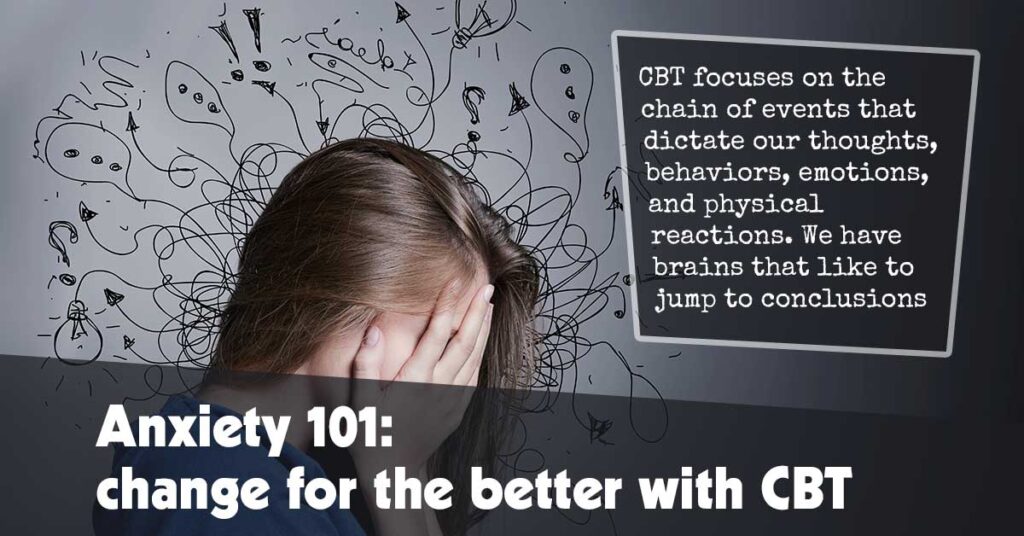WHAT IS CBT?
In the 1950s, psychiatrist Aaron Beck and psychologist Albert Ellis pioneered Cognitive Behavioral Therapy (CBT), an influential form of therapy. Since then, research on CBT has continued apace, making it one of the most highly researched forms. Our first product – Anti-Anxiety Notebook – utilizes CBT for treating depression and anxiety;1 additionally this intervention may also prove effective for anger management, insomnia management, low self-esteem issues, low self-esteem issues as well as any number of mental health matters.
CBT addresses the chain of events that govern our thoughts, behaviors, emotions, and physical reactions. Human brains tend to jump quickly to conclusions in stressful environments – this instinctive reaction serves an essential purpose; but can cause unhelpful cascades of thinking and bodily responses.
CBT helps us take steps in an empowering direction by using its “ABC” model, which highlights what lies within and outside of our control. CBT emphasizes what events, thoughts and consequences trigger an activating event or thought. What we choose to believe determines meaning acceptance, emotional responses felt and bodily sensations experienced – we direct our experiences accordingly and course correct when necessary.
Over time, this loop becomes an automated habit. Time slows down. Images remain still, words remain silent while associations are probed for. There is a pause between impulse and action – you might notice the urge to do, think or say something unhelpful and act upon this awareness in the present moment before choosing an alternative behavior pattern.
How Does CBT Work? In cognitive behavioral therapy (CBT), our goal is to recognize and reframe perceptions in real-time, monitoring unconscious, automatic thoughts. Neuroplasticity states that our brains can change with practice – the more information you integrate and practice, the clearer pathways become in your mind2.
The Anti-Anxiety Notebook will guide you through 100 CBT-based journal entries for in-the-moment support and reflective guidance. Structured exercises provide relief when stressed or simply wanting a different perspective; use it to believe in thoughts that enhance your life, brain, mood and body.
Write about an event. Describe its setting and your emotions by answering who, what, when, and where questions.
Recognize your emotions. Naming our emotional states can give us power; try not to question any feelings you experience.
Track the intensity. Using a scale, rate the intensity of your emotions from barely feeling them to intense feelings; some forms require you to select from 0-100% on this scale. Although quantifying an emotion might seem strange at first, we encourage you to do what works for you or give this method a try – observe whether intensity levels change with time and any circumstances which enhance or lessen the experience.
Recognize patterns. By reviewing previous entries, you might begin to recognize similarities in your habits and processes – this could include any negative thinking styles like “blaming others” or magnifying the negative. Remember that we’re training the brain for new ways of thinking by keeping an eye on any links between unhelpful thoughts and your emotional responses.
Reframe your perspective: In an attentive and kind way, confront your thoughts and find a different perspective to assess a situation – this leads to beneficial action and balanced thinking.
CBT IN PRACTICE: JOURNALING mes We can create our experience of CBT by journaling it. Perceptions influence how we view people and situations; automatic thoughts and feelings may bring forth new insights and behavior changes. When fear centers send alarm signals, however, it’s important to stop, notice, proceed with caution, reflect upon our fears – they don’t dictate our lives!
While implementing new behaviors, guided exercises can be immensely helpful in terms of helping us stick to facts, slow down our reaction time and engage the parts of our brain that may be overactive – all things which help reroute moods and core beliefs. You might also decide to explore further introspection as you review over 100 notes and tips from therapists included in The Anti-Anxiety Notebook.

